The issue of trolls and bots is present on the Internet since the existence of public communication platforms, from chatting to social media. The problem is that these terms are poorly understood and very often misused both in everyday life and in professional communication.
Let us begin with trolling, named after a troll, a malicious creature from Norse mythology, a demon who makes people behave destructively. It is similar to fairies in Slavic mythology.
Trolls on the Internet is the name for users whose comments and messages on public Internet platforms create emotional reactions in people, often initiating long discussions and stream of reactions. The motivation for such behavior on social media may be fun, but most often there is an agenda behind it, usually with the political background.
In Montenegro, the well-known troll page is Stari Liberal with over 17 thousand followers, but there are also many others. Stari Liberal has a secret political agenda and with its publications, it triggers off the reactions of certain ethnic and religious minorities. Its activities influence significantly the creation of public opinion in one part of the public opposition.

The internet bot, also known as the web robot, WWW robot or simply bot, is a software application that launches automated tasks (scripts) via the Internet and may be used for good purposes, such as SIRI on iOS platform or numerous other virtual assistants on Android operating system. Most frequently, bots execute tasks which are simple and structurally repetitive, on a much higher level than it would be possible for a person to do it. However, for this text, it is interesting the use of bots for political purposes.
In our region, bot is usually the term incorrectly used for party activists who are organized in their offices to comment on social media or portals. Sometimes they do it anonymously, and sometimes from their real accounts. In that context, it is more about trolls and not about bots which represent artificial intelligence, while the mentioned activists are real persons no matter whether they have real or fake profiles on social media.
One of the examples of incorrect use, and at the same time the terminology misunderstanding example, was seen in December 2018 when in the public appeared the news from the session of the Executive Committee of the Serbian Progressive Party (SPP), at which the relevant party member in charge of the Internet team published an annual report stating that the SPP had 3,456 persons who had written for one year 10 million comments on over 200,000 published news. Actually, portals such as Al Jazeera Balkans and Danas, reported on this using the term “party bot” in the context of a party soldier assigned to leave comments on web portals and social media. As was already stated, here is more about trolls than about bots (a software).
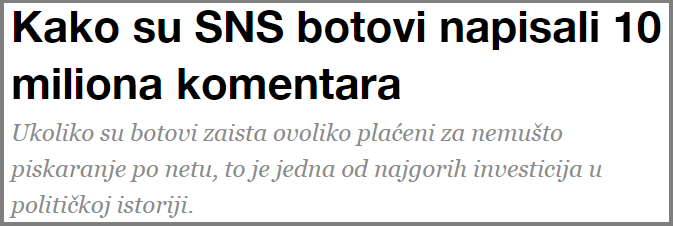
Over the last years, bots have become an inevitable part of online life. It is considered that over 50% of Internet traffic makes exactly these automated programs designed to execute automated tasks. Only last year researches estimated that Twitter alone was home to over 30 million of them; however, they also do exist on other platforms, such as Facebook and Instagram. Some of them are designed in a way to provoke on purpose or to support certain political candidates and ideas, while others are used for commercial purposes.
Though there are many types of bots, “bot-like activity” is typically used only in reference to Twitter. Retweeting things hundreds of times a day, spamming the same link repeatedly, and using multiple accounts to amplify the same message are all good indicators of bot-like activity, but it does not necessarily mean that the account is a bot.
Misuse of social media
We witness many forms of misuse of social media, platforms, and modern communication types (Viber, WhatsApp) for different purposes, from political to economic and financial, in terms of the damaging reputation of business competition by spreading disinformation.
The possibility to buy followers, number of likes, number of views of video content has opened the additional space for social media misuse. Large companies and marketing agencies more frequently refer to so-called “influencers” as a channel type for advertising and messaging. It has opened an entire market in otherwise creative IT sector, which for a short period of time found a program solution so that anyone with a small amount of money can become an “influencer”. Websites such as Buzzoid offer services of online purchase of likes and followers; one may even purchase a number of views of video content on Instagram. Such and similar websites for online purchase of “popularity” exist almost for all social media, but the misuse most frequently happens on Instagram, Facebook and Twitter. In this business, as in many others, the rule is “you get what you pay for”, thus the amount of money you are ready to pay determine not only the number of your followers and likes but also the quality of bot profiles following you. If you are ready to pay a larger amount of money, the Internet portals will provide you followers with real names and of geographic origin similar to yours, while for a smaller amount of money you will get followers mostly from India and China, who are of weaker quality, so that even an unskilled person is able to realize that it is a bot profile.

Soon after the rise of these “popularity” sites, marketing companies and experts, in order to prevent to be defrauded and to pay fake influencers for marketing services, have developed their own tools for „quality“ and „authenticity“ check of followers and likes. So that today with a small amount of money and using websites such as fakelikes.info you may check “the quality” of Instagram and Facebook influencers, or the number of their real and fake profiles that follows and likes them, compared to the number of profiles artificially created and purchased through different online shops.
Currently, for us, it is maybe the case of Dusko Knezevic the most interesting, who opted for Instagram as a political communication channel with the public. For the needs of our Magazine, and as a reaction to the writing of portals in4s.net and slobodacg.me, we have done a detailed analysis of his Instagram profile.
For us who deal with social media, it is clear that these leaps in the number of likes do not happen overnight, and that was the “alarm” for more detailed research.
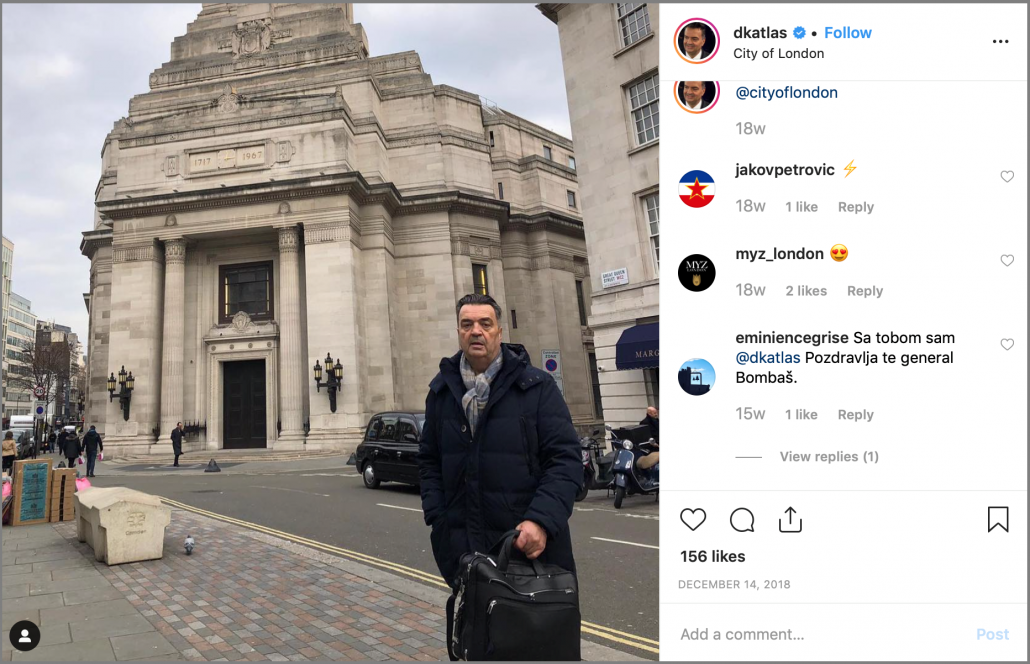

In the photos below, you may see a typical example of bot profiles misuse in order to make a fake performance of support and popularity, what in reality turned out to be a common purchase of bot profiles and journalistic irresponsibility to report on unverified and made up data.


Linking social media with portals has proven to be a powerful weapon for spreading propaganda. Posting on social media is still very anonymous, or it is very hard to trace those who post content on social media, while portals which want to spread a certain type of propaganda refrain themselves from responsibility by “taking” content from social media as a relevant source of information. Additionally, the accountability for posting content on social media, particularly for political purposes, is not clearly defined by law. The election silence prescribed by the laws of Montenegro cannot be applied on the Internet, and we have witnessed all this during previous election cycles.
Examples of misuse
There are numerous examples of misuse and spread of unverified information in mainstream media, when in fact mainstream media did not make additional content check-up or published it on purpose, even though they are aware that it may be disinformation. Such an example happened during the 2015 opposition protests in Montenegro when after the police breaking up of one of the protests, the opposition FB page “Sloboda trazi ljude” posted a photo of alleged injuries caused to protestors with rubber bullets by the police. This news flooded the media in a couple of minutes, even though a simple Google search could reveal a real source of that photo. This time, the photo was “borrowed” from Kosovo, from riots happening there, which was presented within a couple of minutes and with the help of Facebook and media as the 2015 protest’s breaking up.


The considerable activity of the famous Putin’s bot and troll factory from St. Petersburg was noticed many times both in the media and the Internet space of Serbia. Serbia is for a long time in “the Russian focus” as the most important country for achieving the Russian influence in the Balkans, and consequently the Russian media and Internet “machinery” gives special attention to this country. The factory from St. Petersburg, in which several hundreds of people in two shifts of twelve hours write thousands of political comments, reached the headlines of all international media after the testimony of Lyudmila Savchuk, an internet activist, who worked for two months on a secret mission in the abovementioned “factory” and wrote blog posts with the aim of turning Russians against the West. In later investigations, the very factory was directly connected with the Russian “special media wars” waged in Ukraine, Syria, in Crimea, and so on, with special attention paid to meddling in the American Elections and the elections in several European countries. The activities of this factory have been noticed many times even in the Serbian Internet space, but we would like to single one activity out as a typical example of misuse of emotions for political purposes.
Actually, at the end of December 2016, a terrible aircraft crash occurred in Russia where people from the whole ensemble of the famous army choir “Alexandrov” lost their lives; the army choir Russia was so proud of and promoted it as one of the national symbols and “ambassadors” of the Russian culture. On December 30 of the same year, the basketball club from Belgrade Crvena Zvezda had a match where their supporters honored the fatalities by chanting one of the choral songs. That heart-touching gesture of the supporters Delije found its way within a couple of minutes to almost all Russian portals, from RT to others. Apart from the Russian, all Serbian portals reported on this emotion-provoking news, honoring one of the national symbols of Russia.

However, during these very events, it is created the ideal space for sending political messages of brotherhood and unity of the two nations.
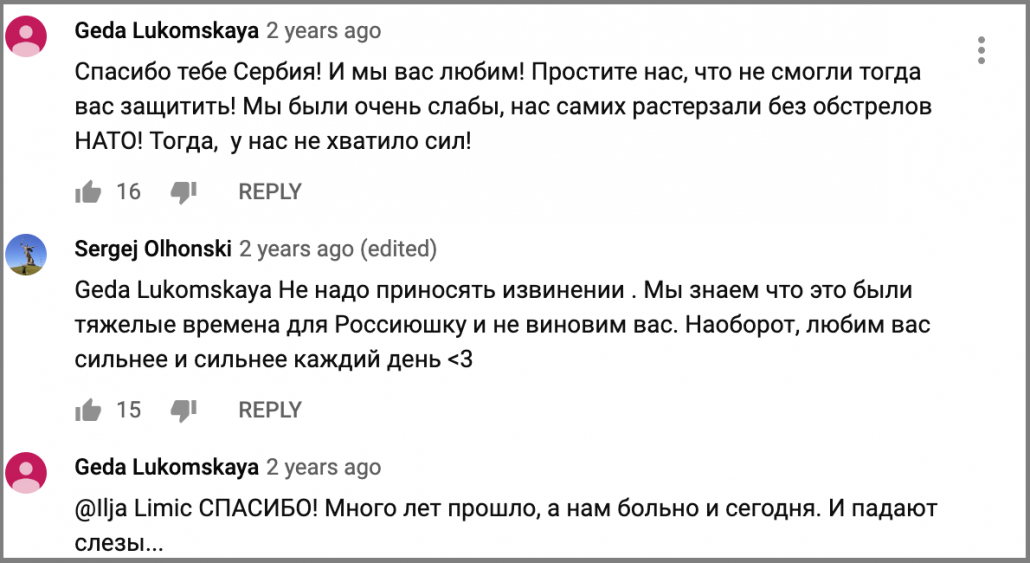


That day, one could find on the Internet thousands of messages, cleverly created and designed to get the affection of the Serbian people. Likewise, a large number of Russians had suddenly started to write as if they were from Serbia, all in the moment of expressed emotions because of the unfortunate and terrible event.
What are the messages that Russia is sending?
1. Russia is strong! It is no more the 1999. No more weak and the West-inclined Yeltsin. Now, there is Putin and he is strong, so as Russia.
2. NATO is a criminal organization. NATO is to blame for all (do not join NATO).
3. Kosovo will be Serbian again, as Crimea is Russian, just stay with us because we are strong now.
If these messages are considered closely, it is noticeable that they reflect exactly the official policy of Kremlin towards Serbia. They get advantage from the frozen conflicts with Kosovo in order to control Serbia with their veto in the UN Security Council. Their plan for Serbia is to keep it away from NATO alliance, and that is why it was important to mention, even during this traumatic and sad event with the Alexandrov Ensemble, who is to blame for the 1999.
Not only that the Russians are direct players in the Balkans’ events, but they also offer very frequently different IT services. Through the current events regarding the “Atlas” affair, it is clear that the Russian IT experts were involved in there. The group behind the association “Gotov je”, composed of the representatives of the parties Demos, Crnogorska and Demokrate, opted for Viber – application largely popular in Montenegro – to have as many dissatisfied citizens as possible join their protests. However, what many Viber users noticed and what made the public wonder is the question why all these messages about the opposition gatherings under the title “Gotov je” were sent from numbers from abroad, particularly from Russia and Belarus. A large part of the messages the Montenegrins received was sent by Viber profiles that already had names there and that indicated the Russian origin: Anna Bratkova Dmitry Maloletkov, Alexander Alexandrov; however, there were also those sent without indicated names and from numbers starting with +7.
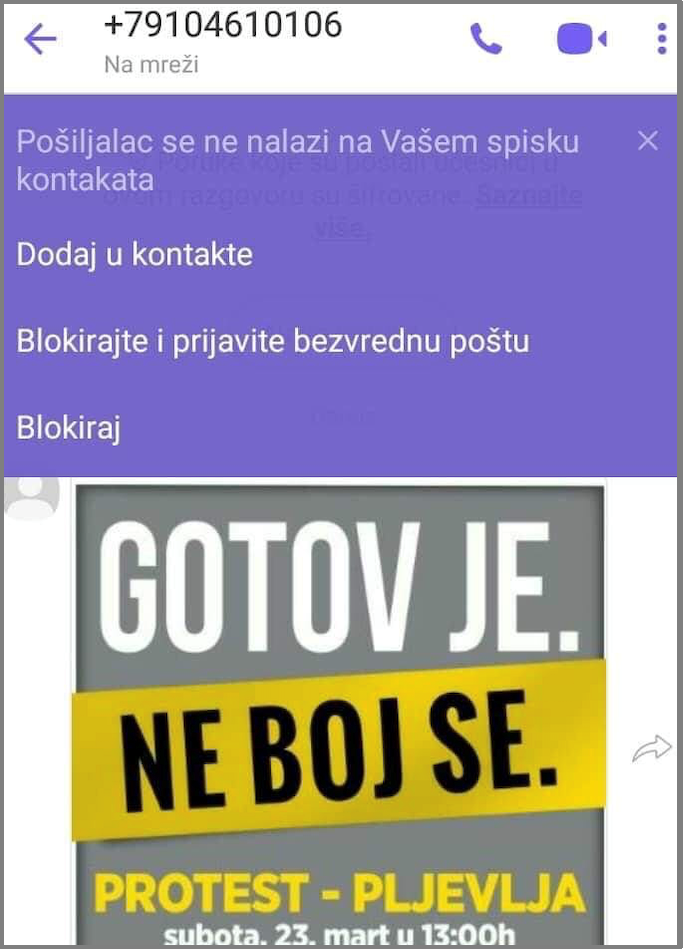
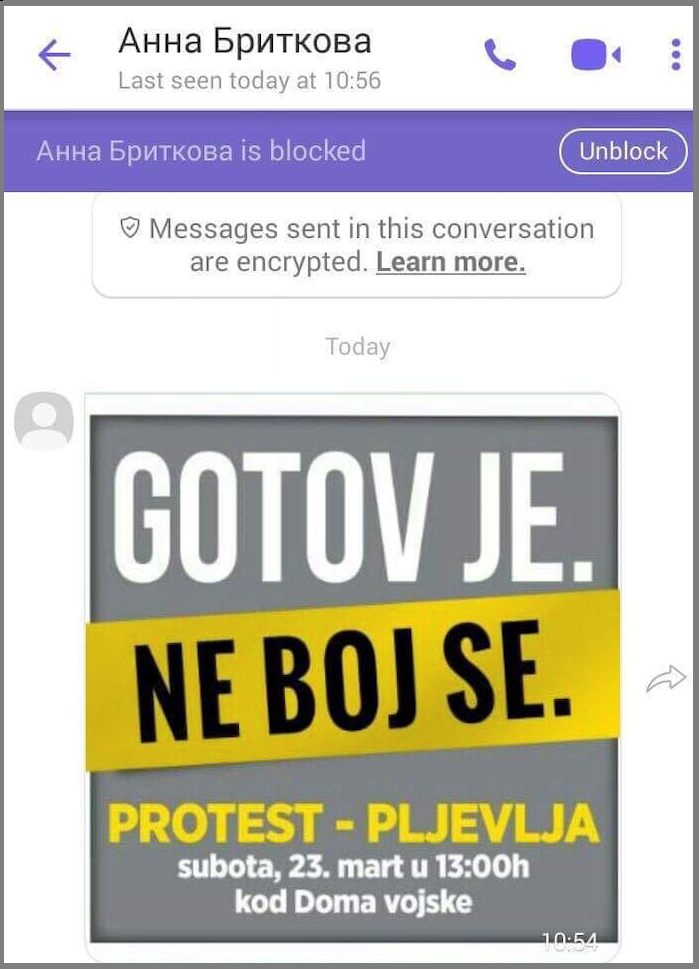

The power of bots and trolls lies in their ability to deceive humans. A report by RAND Corporation, an American nonprofit policy think tank, listed a number of recommendations for defending democracies in the advent of malicious bots and trolls on social media. The group’s recommendations include technical approaches such as developing and implementing more effective identification and tagging methods for bots and trolls, as well as “offline” solutions such as educating the public to be more vigilant against fake news and rumors.
Instead of relying solely on social media companies to fight this fight alone, the report recommends that countries educate their citizens on media literacy, expand and improve on content created by local trustworthy news outlets, allowing it to better compete with foreign state-sponsored propaganda, and empower influencers on social media.

